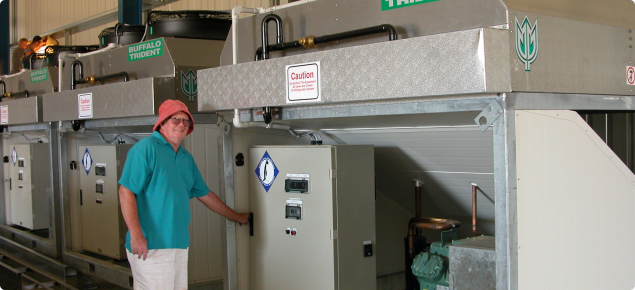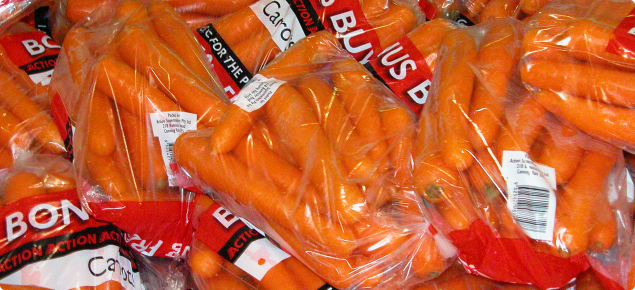Growing condition effects
A balanced nutritional program is important to producing a high quality root with good keeping qualities. Ideally the crop will have run low on nitrogen in the week or two prior to harvest in order to reduce the risk of postharvest bacterial breakdown.
If irrigation is reduced close to harvest in an effort to dry out the soil to minimise the sand or soil that is lifted with the crop, it is most important that the roots don’t begin to desiccate.
Carrots grown for market usually remain in the vegetative phase. This contrasts with most fruit and many vegetables (for example, broccoli) that reach a defined and measurable maturity. Nantes carrots can be considered 'mature' when the root tips have filled, reaching the typical blunt-ended appearance.
Root size usually determines when carrots are harvested. It is important that yield and packout of the market-preferred sizes are optimised to maximise returns. Harvesting early to fill orders will sometimes mean that yields and hence profits are reduced. If harvest is delayed it is important that foliage diseases are managed and the level of root diseases is monitored to ensure serious crop losses are avoided.
Risk of bacterial breakdown is much higher in carrots harvested during hot weather. At these times, harvest during cool parts of the day.
Harvesting early in the morning will reduce dehydration and time for carrots to cool down. High temperatures accelerate the growth of disease-causing fungi and bacteria.
- In cold wet weather, splitting and breakage can cause serious losses particularly in susceptible varieties. In general, Imperator varieties are less prone to breakage than Nantes varieties, which are generally less susceptible to breakage than Kuroda.
- Harvest into clean bins and crates. This will minimise the spread of disease.
- Minimise the drop height. Excessive drop heights lead to more bruising, splitting and breakage. Adjust machinery in the field and on the packing line to lower the drop height. Carrots dropped at the beginning of the packing line should have some padding to eliminate bruises, cracks and abrasions that serve as entry points for decay-causing fungi and bacteria.
- Transport carrots carefully - avoid excessive bouncing and shaking in bins to reduce bruising and splitting. In hot weather, cover the carrots with a tarpaulin during transport.
- Never keep harvested carrots in the sun. Shading will reduce dehydration. Heated carrots lose quality and dehydrate more quickly.
- Coolstore carrots immediately after washing them. Where carrots are hydro-cooled after washing, they can be packed and then coolstored immediately. This greatly reduces the risk of postharvest diseases.
- Chlorination (50 to 100 parts per million available chlorine and water pH 7.0 to 7.6) is only recommended if carrot breakdown is observed. It is likely that management practices in the field, and weather conditions predispose carrots to bacterial soft rot. Washing water should be changed as often as practical.
Storage conditions
Minimum quality requirements are that carrots should be intact, sound, clean, free from attack by diseases, pests, mould or rot, and without foreign smell or taste.
- Storage life depends on storage temperature and humidity.
- At 20°C and 60–70% relative humidity, carrots will keep for two to three days.
- At 4°C and 80–90% relative humidity, carrots will keep for one to two months.
- At 0°C and greater than 95% relative humidity, carrots will keep for up to six months.
- The ideal conditions for best keeping quality are pre-cooling and storage at 0°C and 95–100% relative humidity.
- The recommended temperature for storage is 0 to 2°C.
General facts
- Ideally, carrot should be cooled to below 5°C within 24 hours of harvest.
- Preferred cooling methods are hydro-cooling, forced-air cooling or hydro-vacuum cooling.
- Ideal conditions for long-term storage are at 0°C and greater than 95% relative humidity.
- Carrots freeze at about –1.4°C.
- Carrots are susceptible to dehydration. Silvering (‘white scale or white blush’) results from dehydration of the partially removed outer skin (periderm) of carrots. Further dehydration results in development of phenolic browning in tissue beneath the periderm. Use of liners during storage and transportation increases moisture retention, reduces dehydration, and hence reduces silvering and phenolic browning.
- Brush polishing removes the periderm from carrots solving the silvering problem but exposing roots to phenolic browning. Browning is initiated by physical damage of the surface during harvest and postharvest brushing, thereby exposing the internal tissue to oxidation. Browning usually develops when carrots are on the market shelf after a period of cold storage.
- Carrots are sensitive to ethylene, so avoid mixed storage with ethylene-producing produce such as tomatoes, melons, apples, pears, plums, kiwifruit and avocados. Ethylene causes development of bitter flavours by stimulating production of compounds called isocoumarins.
- Available chlorine at 50 to 100 parts per million (ppm) in clean rinse water reduces likelihood of bacterial and fungal breakdown. For chlorine to be effective, water pH has to be maintained from 7.0 to 7.6.
- There is no advantage in holding whole fresh carrots under controlled atmosphere storage.
Packaging checklist
- Common name or description of product
- Net weight or volume
- Country of origin
- Date of packaging
- Special storage requirements
- 'Perishable' and 'Handle with care' sign
- Certification logos such as SQF quality assurance, if applicable
- Packer/grower code


